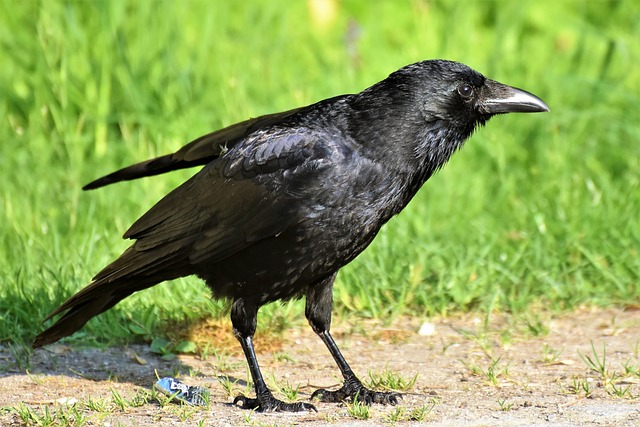By Tim Lambert
Old Crawley
Crawley began as a Saxon village. It was originally called crow leah. The old English word leah meant a clearing so it was the clearing with crows.

However, by the 13th century, Crawley had grown into a small market town. (This was partly because it lay on an important road from London to the South coast). From 1202 there was a market in Crawley every Friday. (In the Middle Ages there were few shops and if you wished to buy or sell goods you had to go to a market).
From 1279 there was also an annual fair in Crawley on 28 August. In the Middle Ages fairs were similar to markets but they were held only once a year. The Crawley fair attracted buyers and sellers from a wide area.
There would have been some craftsmen in Crawley such as brewers, bakers, blacksmiths, and carpenters but it was essentially an agricultural settlement. Men would farm the fields around Crawley. At the market and fair the main goods on sale were food and livestock.
Crawley would seem tiny to us. It only had a population of several hundred people but towns were tiny in those days. An average village had only 100 to 150 inhabitants.
For centuries Crawley was only a small town. In the 18th century, it grew slightly bigger. Meanwhile, in the late 18th century Brighton began to develop as a seaside resort and lots of people from London traveled there by stagecoach. Crawley was at the midpoint of the journey and began to develop as a stage-coaching town. But Crawley was still quite a small town. In 1801 Crawley and the adjacent villages still only had a combined population of about 2,000.
THE GROWTH OF CRAWLEY
However, the railway reached Crawley in 1848. Railways meant the end of stagecoaches, of course, but Crawley continued to grow in the late 19th and early 20th centuries. In the late 1880s, a network of drains was built in Crawley. From 1897 the tiny town had a piped water supply and in 1909 the first electricity generating station was built in Crawley. In 1939 a bypass was built.
However, the Crawley fair, which had been held each year since the 13th century, was discontinued because it interfered with traffic. The last one was held in 1924.
Then in 1930, an aerodrome was built at Gatwick. It was taken over by the RAF during World War II but returned to civilian use afterward.
In 1947 Crawley and its adjacent settlements still only had a population of about 10,000.
THE NEW TOWN OF CRAWLEY
In 1946 the New Town Act was passed. The idea was to move people and industry out of London to several new towns between 20 and 40 miles from the metropolis. Crawley and its surrounding villages were selected as a site.
In 1947 the decision was formally made that houses and factories should be built on 6,000 acres in the area. A Development Corporation was set up with powers to build infrastructures such as roads, drains, and sewers. Many council houses were also built but it was planned that Crawley should have a ‘social mix’ with both council and private housing.
In 1951 a new plan for Crawley was made public. It was planned to create a town center and 9 neighborhoods. (Today there are 13). The plan was that each of these neighborhoods in Crawley should be, to some extent, self-contained with shops, churches, schools, and leisure facilities. Work progressed rapidly and new houses were ready by 1949.
Broadwalk was ready by 1954 and Queens Square was finished in 1958. The first of the ‘neighborhoods’ to be built was West Green, in the early 1950s. It was followed by Northgate, Three Bridges, Langley Green, and Pound Hill. Then in the late 1950s, Southgate was built. So was Gossops Green.
In 1956 Crawley was made an Urban District Council. Crawley Development Corporation was wound up in 1962, and its work was done. In 1974 Crawley was made a Borough. In 1976 it was given a coat of arms and in 1983 the boundaries of Crawley were extended.
By 1971 Crawley had a population of 67,000. In the 1970s there were new developments at Bewbush and Broadfields. In 1975 Queensway was pedestrianized.
In the 1950s an industrial estate was built Northeast of Crawley. (Manor Royal Industrial Estate). New industries included engineering, electronics, printing, and plastics.
In 1958 the aerodrome at Gatwick was made an international airport. In the late 1950s and 1960s, air travel became much more common and so Gatwick Airport expanded rapidly. Also in 1958, Crawley College of Further Education was founded.
In 1988 The Hawth Theatre and Exhibition Centre was built and in 1992 Crawley Shopping Centre was greatly expanded with the building of the County Mall. Also in the 1990s, Maidenbower private housing estate was built. Then in 1999, Crawley Leisure Park was opened with restaurants and bars.
CRAWLEY IN THE 21ST CENTURY
In the 21st century, Crawley is a thriving town. A new library opened in Crawley in 2008. In 2023 the population of Crawley was 118,000. Today Crawley is growing rapidly.